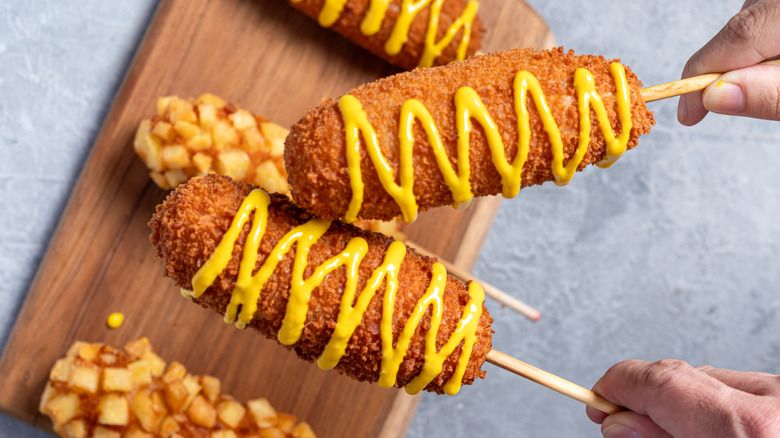What Everyone Gets Wrong About Making Corn Dogs And Corn Dog Nuggets At Home
The origins of the corn dog have been shrouded in mystery; some stories claim it was invented in Buffalo, New York, in the 1920s, while others say it popped up in other parts of the country in the 1940s. Regardless, this classic state fair treat is made by dipping a hot dog on a stick into a cornmeal-based batter, then deep frying it. But when making the perfect corn dogs or bite-sized corn dog nuggets, there is one thing everyone gets wrong: not drying the hot dog beforehand.
If you've ever purchased a pack of hot dogs — and thankfully, Chowhound rounded up the best and worst hot dogs at the store — then you know they often sit in a small amount of moisture. Condensation can also bead up when they go from the refrigerator to the counter. Without properly removing this moisture, the batter can't stick as well, resulting in an imperfect corn dog coating. Not only does a dry hot dog help the batter stick, but water and oil don't mix; frying anything that's too moist can result in potentially dangerous splattering.
Coat hot dogs in flour to help the batter stick
To ensure the batter properly sticks, you can coat the hot dogs in flour, which will help absorb the moisture while also acting as an adhesive between the batter and the hot dog. Once the hot dogs have a thin flour coating, properly batter them by adding the liquid batter to a tall glass (a tall, narrow vase would even work), then dip the hot dog in all at once. Avoid twisting the hot dog in a shallow bowl, because the coating won't distribute as evenly.
If you don't have flour available, gently pat the hot dogs with paper towels to remove any surface moisture. Repeat this as needed until no liquid transfers from the hot dog to the paper towel. For an extra crunchy corn dog or corn dog nuggets, you can make a Korean-style corn dog. The Korean version uses panko, which is crunchier than breadcrumbs, instead of a cornmeal-based batter.

